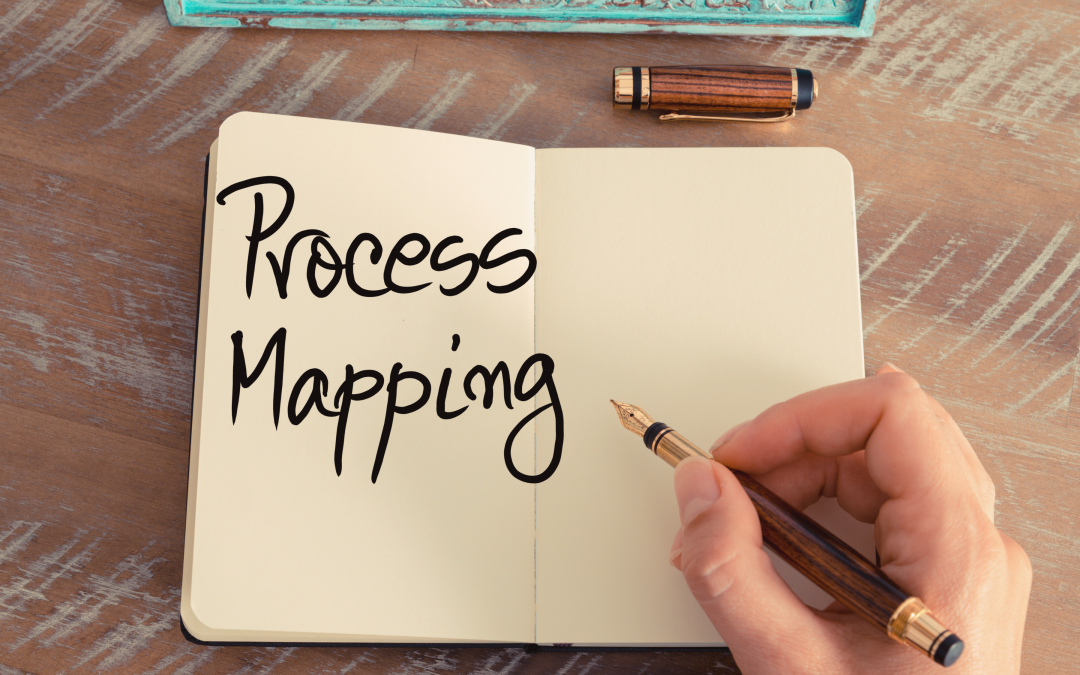What is Process Mapping?
Process mapping is a simple technique and one of many thinking tools used for business improvement.
It’s a great technique for helping people in organisations to see what is happening and it’s closely related to customer journey and value stream mapping techniques.
This technique helps us to identify where we can save time, cost and improve customer value in any sized business or industry (and even in our personal lives).
Process mapping is setting out step by step, how things happen. It’s simple yet powerful to highlight where things might be going wrong, where there is duplicated effort, waste, rework, time delay, non-value adding tasks or variation. Some processes are more complex than others, until you set it out step by step you may not “see” the opportunities for improvement.
Everything in life happens through a process – from making a cup of tea, getting to work, recruiting, selling, delivering a service, purchasing and planning, right through to complex manufacturing processes. The best companies in the world understand and manage their processes. Quality accreditation also requires standardised and repeatable processes.
My Old Invoice Process – a Great Example!
Here’s an example of a simple linear process map – the manual process I set up with good intention when I started my business:

That was my old invoicing process. Can you see the laborious wasted effort, where small changes or automation could make things quicker and easier?
The old process was also subject to (my) human error. The customer doesn’t pay for my time-consuming process and I don’t get more time to spend doing other things I enjoy (like gardening).
Shown below here, you can see my new invoicing process, which has gone from 12 steps down to less than 7 steps because many of the steps are now automated, taking a quarter of the time of the old process.
If I’m doing a lot of invoicing, it’s going to save a lot of time. It’s also so much quicker now to complete other financial processes like financial reporting and lodging quarterly BAS.

Note – this is an example only to show how mapping a process can be beneficial. You have your own processes.
10 Tips for Successful Process Mapping
- Involve the people in the process (e.g. your staff, suppliers). Map the process together – you will find out what actually happens, instead of what you think happens;
- Use a verb (action word) and a noun (thing or object word) to describe each step;
- Use butchers’ paper and post it notes to initially capture the steps – it’s easier to make changes. You can transcribe your working map to something neater later;
- Each square/rectangle represents a step in the process called a task box. Use a diamond (sideways post it note) when there is a decision point (“what happens next depends on…” and then you may have two processes branching off);
- Use arrows to show the flow;
- Consider whether you are mapping the process high level or in detail – the level of detail required depends on what you are trying to achieve;
- Parallel map anything that happens simultaneously;
- Keep asking “what happens next…”
- Record who does each task if there are multiple people or work areas involved in the process;
- Once the process is mapped, have a conversation about how the process can be improved – Is there duplication? Are there non-value adding steps that can be removed? Can we automate any parts of this process? Can we reduce the time the process takes? Where can we reduce cost? What does the customer value and how can we change the process to deliver better service?
4 Advanced Tips for Process Mapping Pros
I like to keep things simple, but if you are looking for pro tips:
- Try swim lane mapping when you want to show different roles in the process responsible for different steps. Swim lanes are horizonal or vertical columns, each representing someone’s role in the process;
- Use different symbols and task shapes for different things e.g. symbols for documents, IT systems, sub processes, etc;
- Capture detail about actual (time it takes to do the task) and elapsed time (wait time) for each step;
- Convert your process maps to procedures – for induction, accreditation and for reference – to enable consistency in how your staff do their job.
Once you start thinking about processes, you’ll find opportunities for improvement everywhere. Take the time to work “on your business, not just in your business” and you will continuously improve.

ARTICLE BY
Heather Falckh,
Co-Improvement
Heather Falckh has the best job in the world – she gets the opportunity to work with you to achieve your goals and live similar core values. She believes in bringing people along on the improvement journey and ensuring they own the solutions.
With over 25 years’ experience in the use of process improvement and business improvement methodologies, Heather is an improvement specialist and has led implementation of improvement strategy in public and private organisations.
Having deep practical experience, she uses a variety of tried, tested and well-known improvement methodologies. They always deliver outcomes.

